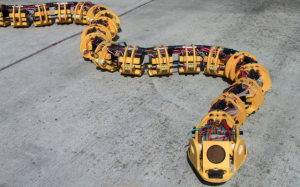No need to call Samuel L. Jackson about this one! British jet engine manufacturer, Rolls-Royce, is developing robots with a snake-like appearance for use in the detection and repair of damage to aircraft engines.
A typical jet plane engine consists of a vast number of sensors to monitor engine conditions such as pressure, temperature, and vibrations. These sensors are monitored by ground-based machines that use intelligent algorithm technology. However, what if a bird were to hit a fan, or debris damage a compressor blade? For issues such as these, engine inspection is required.
Engine inspection is currently the job of a fibre-optic device called a borescope, which can be manually placed into a jet engine port by a borescope specialist. Unfortunately, there are far too few of these specialists available to operate borescopes within the 14,000 Rolls-Royce engines, flown by 500 airlines on 4000 aircraft worldwide.
“We don’t have enough specialists to go around so we need to automate this capability,” says Rolls-Royce senior vice-president Pat Emmott.
Another problem with the borescope is that once it detects an engine issue, the plane must be entirely taken out of commission in order to disassemble and repair the engine. This process is a setback that costs airlines millions of dollars.
Rolls-Royce aims to mitigate these challenges through the use of robotic snakes. This initiative is part of a €4 million European research project called “MIRoR”, which aims to be completed by July 2014. The hope is that these robots will potentially save significant time and money when airlines run into engine problems.
Wondering how they work? The snake robots enter an engine and are remotely controlled to relay images to an expert. Keep in mind that a running aircraft engine can reach up to 3,000-degree Fahrenheit temperatures. “These cameras won’t have to operate at engine temperatures — just survive them,” says Emmott. “So we’re going to need some interesting ways to keep them cool.” In addition to a camera, the snakes will also exhibit a UV laser to detect blade fractures, and an apparatus to sand down damaged compressor blades.
The snake will have to be of a substantial length in order to be effective for use in a jet engine. Rob Bukingham, director of OC Robotics in the UK, sees battling gravity as the biggest issue in this innovation, since the longer the snake, the more difficult it will be to control. According to Buckingham “the more joints you add, the more difficult it becomes to maintain the curviness.”
Interested to see these cool snakes in action? Take a look at this video to see a similarly designed robot snake designed by OC robots. This particular snake is able to cut metal and concrete!




